Open Air Nursery School
Open Air School
In the wake of the LCC establishing the initial open air schools for delicate children of school age, there were moves from the voluntary sector to apply the same principles to very young children from the poorer working-class districts of London. Pioneers in this regard were two sisters - Rachel and Margaret McMillan.
The McMillans, both Christian Socialists and educationalists, campaigned for the improvement of education and health of slum children and, in 1908, had established a London School Clinic in Bow. Early in 1910 they moved the Clinic to Deptford, one of London's more deprived areas. The Clinic provided dental and medical care, as well as lessons in breathing and posture. The children were generally debilitated and 80% had rickets.
In 1911 the Clinic was located in Evelyn House, at No. 353 Evelyn Street, which had been given rent-free to the sisters by Mr and Mrs John Evelyn (who joined the managing committee). A small Nursery School and Baby Camp was established in the garden of Evelyn House. Within a few weeks of its opening, the School had 30 children, their ages ranging from 18 months to 7 years. Later, a Girls Camp was established so that girls over the age of 8 years slept in the garden at night. A Boys' Camp was set up at No. 24 Albury Street and, by 1912 a 'night camp', where 12 to 16 boys over the age of 8 years could sleep in the open air every night among the tombstones in the old churchyard of St Nicholas. The younger siblings of the children attended the Nursery School during the day.
In 1913 the LCC was approached by the American philanthropist, Joseph Fels, the manufacturer of naphtha soap, with regard to an acre of vacant land off The Stowage at the top of Deptford Church Street (this part of the road, and the adjacent Wellington Street, were later renamed McMillan Street) for the Camp Schools. The site had been set aside by the LCC for a future elementary school, but offered the potential of more substantial quarters for the Schools. The LCC agreed to lease the land at a nominal rent of one shilling (5p) a year (on the understanding that the arrangement could be terminated at a day's notice) and, in March 1914, the McMillan Camp Schools moved to the new location.A Baby Camp was established initially for 6 children. By the summer some 29 children, aged from 3 months to 5 years, lived at the School and slept in the open air at night.
At the outbreak of WW1, the sisters approached the Ministry of Munitions via the Board of Education, offering to take the children of married women working in munition factories. For this, the School received a grant of 7d (3p) a day for each child of a munition worker.
Rachel McMillan died on her birthday, 25th March 1917. In the summer of 1917 the School was extended and the new buildings opened by the Minister of Education, Mr H.A.L. Fisher on 3rd August. The School was renamed by Margaret as the Rachel McMillan Nursery (as its entrance is still styled).
The new School consisted of several 'shelters' or pavilions which could hold between 35 to 50 pupils each. The simply furnished shelters, reputedly designed by Rachel, were deliberately light timber and asbestos constructions, intended to be modified or replaced easily, to support changing numbers of pupils and requirements. When later constructions included a considerable amount of glass, the result was said to resemble a greenhouse environment.
The shelters contained cupboards to store the beds and blankets. Tables and chairs were put away each afternoon at the end of the school day. Each shelter had its own bathrooms, with the one used by the toddlers fitted with several pot-baths. Each bath and sink had its own hot and cold water taps.
The doors of the School were open at 07.30 hrs, when the mothers could drop their children off on the way to their factory work. Most arrived between 08.00 and 09.00 hrs and first of all visited the bathroom to wash and clean their teeth. Each child was provided with a peg on which to hang their bag containing a flannel, a towel and a toothbrush. After a breakfast of porridge and milk at 9 o'clock, 'lessons' began. The mornings were spent doing hand work or playing in the garden (or in the shelter in poor weather).
At lunchtime, held between 11.30 and 12 noon, children over 3 years of age were allowed to help themselves from a little serving dish passed round by a 'monitor' (another child).
After the 2-course lunch the older children helped to clear the tables and set out the camp beds and blankets for the midday rest.
The afternoon activities consisted of free play, music and games.
Tea was served at 16.00 hr and school finished between 17.00 and 17.30 hr, when the working mothers would collect their children
While beginning entirely from the voluntary (charitable) community, the Education Act, 1918, permitted local education authorities, such as the LCC, to support nursery schools, both financially and with medical services. The McMillan Nursery was soon recognised and aided.
In 1919 the LCC agreed that Margaret McMillan could continue with the Nursery for five years, on condition that she relinquished all claim to the property (including the buildings) in September 1924. In 1924, and in subsequent years, the agreement was renewed.
In 1920 the School received its first grant from the LCC. Brick offices (WCs) were built for the shelters. The Nursery was recognised by the Board of Education as a Teacher Training Centre.
In the summer of 1921 some 135 children were attending and the School had to turn away pupils. Margaret McMillan approached the LCC with a view to extending the School with an extension to accommodate 100 children. The LCC agreed and the new extension (funded by the LCC) was completed on 5th September and was officially opened by Queen Mary on 22nd November 1921.
During the 1920s, the School functioned as parallel voluntary and state (LCC) establishments sharing the site and the same superintendent. In 1923 the Nursery and School contained 300 pupils aged from 2 to 12 years, 212 of whom were under the age of 5 years. The 300 meals for the children were prepared by one cook and one helper.
In 1924 temporary premises to provide more School places were obtained in Wellington Street.
By 1927 another shelter was built. The School had 260 places, of which 160 were in the voluntary part and 100 in the LCC's part.
In 1930, with financial help from Lloyds of London, new buildings for a training college for teachers and nursery nurses were set up in Creek Street. The Rachel McMillan Training College opened on 8th May 1930 (it became part of Goldsmiths College in 1976).
In 1931, on the death of Margaret McMillan, the entire School came under LCC control.
In 1932 the premises in Wellington Street were required for a housing scheme. Another shelter was built on the Stowage site, although the pupil complement of 260 places remained the same. A weekly charge of 1s 8d (8p) was paid by the parents who could afford it.
Throughout the 1930s the School had been extended and improved; the earliest shelters were replaced in 1936. The six open air shelters stood in a large garden and were self-contained, with separate cloakrooms, bathrooms and sanitation. The garden had an attractive playground with a slide, a 'jungle gym' and little pathways. Rabbits and guinea pigs were kept as pets, and there were an aviary and a dove cot. LCC doctors visited weekly and, if any child needed treatment, they were referred to the Rachel McMillan Treatment Centre in Reginald Square.
From the beginning, graduates from the Open Air Nursery were found to have a considerable advantage in weight and general health, compared to their peers, on entering primary school at the age of 6 years.
Present status (January 2013)
This was the first open air nursery in England, and the McMillans' work and example has been a model for nursery education internationally. The establishment continues, as the Rachel McMillan Nursery School and Children's Centre. It maintains the original educational approach, with up to 138 pupils learning through play and exploration, for 15 or more hours a week.
Margaret and Rachel McMillan are buried together in Brockley Cemetery, close to the Brockley Road entrance.
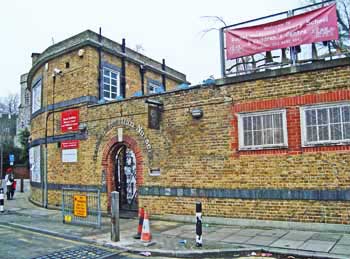
The western elevation of the Nursery School (above and below) along McMillan Street.
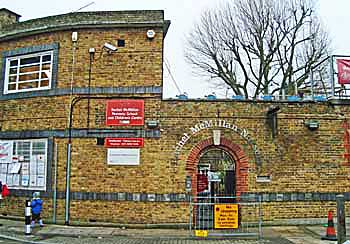
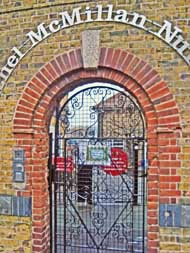
The gated entrance to the School yard.
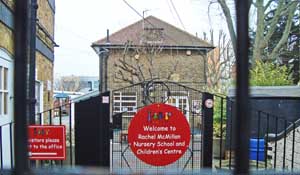
The buildings in the courtyard seen through the gate.
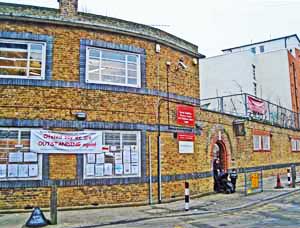
The northern elevation on Stowage Street.
(Author unstated) 1917 The Rachel McMillan Baby Camp.
British Journal of Nursing Supplement, 11th August, 96.
(Author unstated) 1929 Stowey House. An Open Air School. Canadian Nurse 25, 32-35.
Franklin G 2009 Inner-London Schools 1918-1944. A Thematic Study. Portsmouth, English Heritage.
Lascarides VC, Hinitz BF 2000 The Rachel McMillan Nursery School. In: History of Early Childhood Education. London, Routledge. Pp. 120-124.
McMillan M 1919 What the Open-Air Nursery School Is. London, The Labour Party.
Stevinson E 1923 The Open Air Nursery School. London, J.M. Dent & Sons.
http://ah.brookes.ac.uk
http://carolineld.blogspot.co.uk
http://transpont.blogspot.co.uk
www.aim25.ac.uk
www.britishpathe.com (1)
www.britishpathe.com (2)
www.educationengland.org.uk
www.london-footprints.co.uk
www.lookandlearn.com
www.oxfordnb.com
Return to alphabetical list
Return to home page